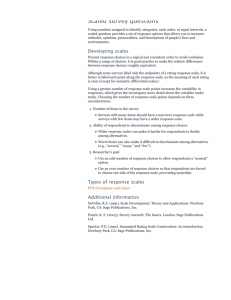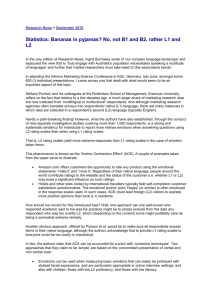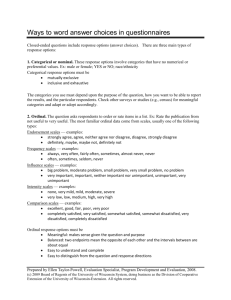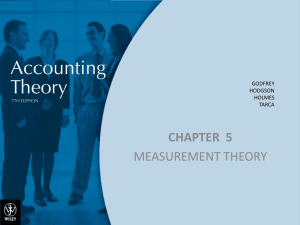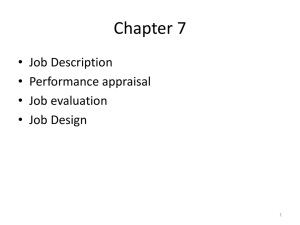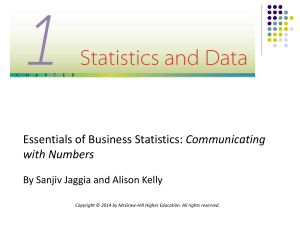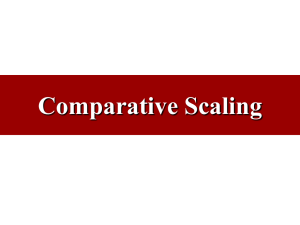Class-4-Measurement-Scales-and-Questionnaire
advertisement
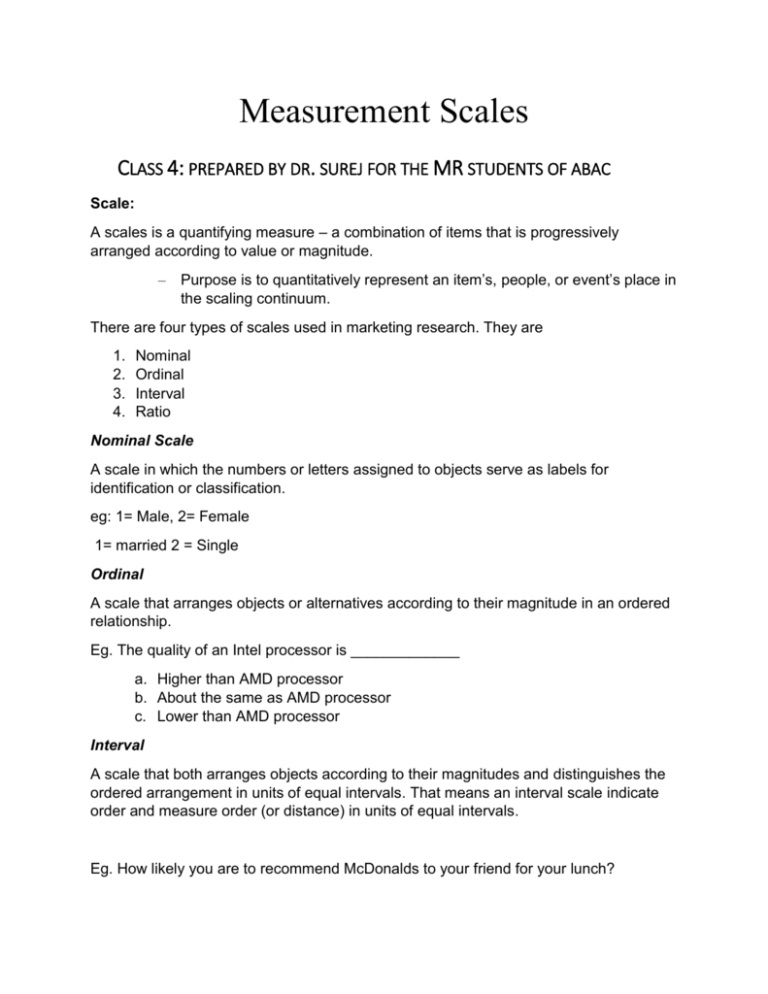
Measurement Scales CLASS 4: PREPARED BY DR. SUREJ FOR THE MR STUDENTS OF ABAC Scale: A scales is a quantifying measure – a combination of items that is progressively arranged according to value or magnitude. – Purpose is to quantitatively represent an item’s, people, or event’s place in the scaling continuum. There are four types of scales used in marketing research. They are 1. 2. 3. 4. Nominal Ordinal Interval Ratio Nominal Scale A scale in which the numbers or letters assigned to objects serve as labels for identification or classification. eg: 1= Male, 2= Female 1= married 2 = Single Ordinal A scale that arranges objects or alternatives according to their magnitude in an ordered relationship. Eg. The quality of an Intel processor is _____________ a. Higher than AMD processor b. About the same as AMD processor c. Lower than AMD processor Interval A scale that both arranges objects according to their magnitudes and distinguishes the ordered arrangement in units of equal intervals. That means an interval scale indicate order and measure order (or distance) in units of equal intervals. Eg. How likely you are to recommend McDonalds to your friend for your lunch? 1 2 3 4 Definitely will not recommend 5 6 7 definitely will recommend Ratio: A scale that has absolute rather than relative quantities and an absolute zero where a given attribute is absent. Money & weight are good examples of attributes that possess absolute zeros and interval properties. Eg. How many movies you watched during the last week? ------------ no. of times Classification of scaling techniques. Comparative scale – Involve the direct comparison of two or more objects – This scale require a judgment comparing one object, person or concept against another on the scale. Non comparative scale – Objects or stimuli are scaled independently of each other. – This scale require a judgment without reference to another object, person or concept. Paired comparison scale • Respondent is presented with two objects at a time • Then asked to select one object in the pair according to some criterion • Data obtained are ordinal in nature – Arranged or ranked in order of magnitude • Easy to do if only a few items are compared. • If number of comparisons is too large, respondents may become fatigued and no longer carefully discriminate among them. Eg. For each pair of professors, please indicate the professor from whom you prefer to take classes with Marketing Research Rank order scale • Respondents are presented with several objects simultaneously • Then asked to order or rank them according to some criterion. • Data obtained are ordinal in nature – • Arranged or ranked in order of magnitude Commonly used to measure preferences among brands and brand attributes Constant sum scale Respondents are asked to allocate a constant sum of units among a set of stimulus objects with respect to some criterion Units allocated represent the importance attached to the objects. Data obtained are interval in nature Allows for fine discrimination among alternatives Example 2: Evaluate Toyota Yaris Non Comparative Scales. Continuous rating Scale Performance of your Mobile Phone is ________ Likert Scale • Extremely popular means for measuring attitudes. • Respondents indicate their own attitudes by checking how strongly they agree/disagree with statements. • Response alternatives: – • “strongly agree”, “agree”, “uncertain”, “disagree”, and “strongly disagree”. Generally use either a 5- or 7-point scale Semantic Differential Scales • A series of numbered (usually seven-point) bipolar rating scales. • Bipolar adjectives (for example, “good” and “bad”), anchor either ends (or poles) of the scale. • A weight is assigned to each position on the rating scale. – Traditionally, scores are 7, 6, 5, 4, 3, 2, 1, or +3, +2, +1, 0, -1, -2, -3. Eg. Measuring Attitudes toward Tennis Stapel Scales • Modern versions of the Stapel scale place a single adjective as a substitute for the semantic differential when it is difficult to create pairs of bipolar adjectives. • The advantage and disadvantages of a Stapel scale, as well as the results, are very similar to those for a semantic differential. • However, the Stapel scale tends to be easier to conduct and administer. Graphic Rating Scales A graphic rating scale presents respondents with a graphic continuum.

